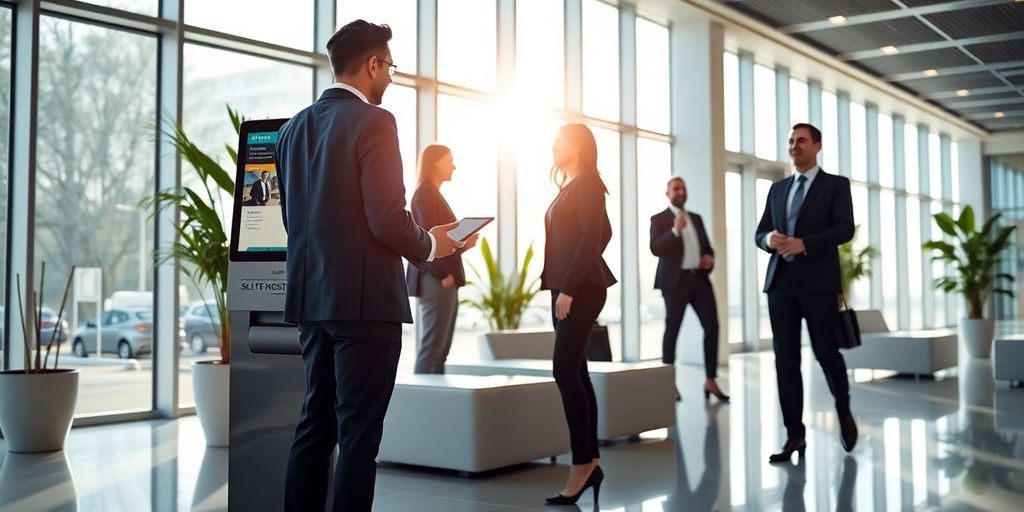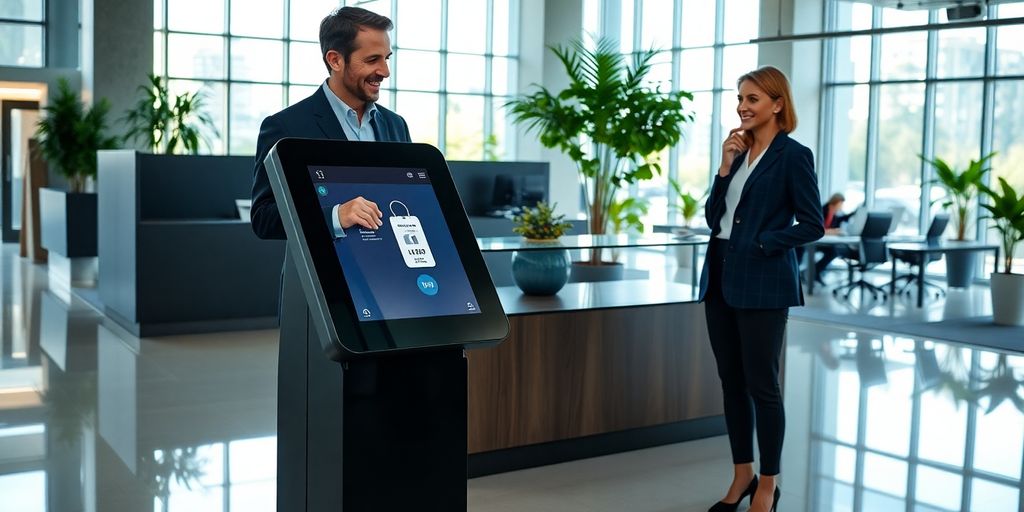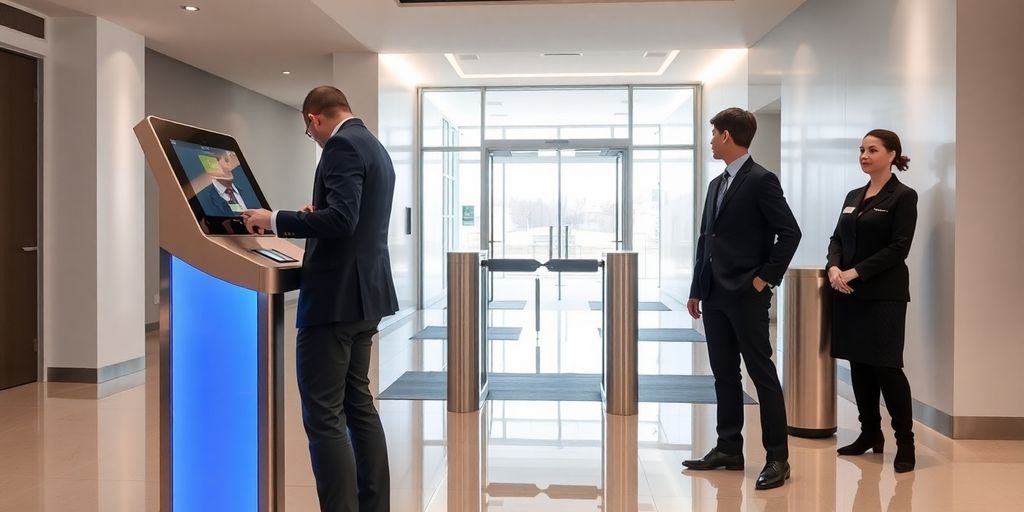In 2025, I walked into my office lobby for the first time since we set up an automated front desk system, and I did a double take. No more messy sign-in sheets or scrambling to call hosts. The system guided me through check-in, printed my badge, and pinged my host in seconds. It even scanned my ID and gave me a one-time code for the door. Sure, the badge printer can jam now and then, but overall, it saved us a ton of time.

First impressions matter. In 2025, that first impression is often made by a system, not a person. An automated front desk isn't just about replacing a receptionist; it's about creating a better experience for everyone who walks through your door. It's about efficiency, security, and making people feel welcome. Let's face it, nobody likes signing into a tattered paper logbook.
Imagine a visitor arriving and being greeted by name, before they even say who they are. That's the power of contextual check-in. It uses data to personalize the experience from the start. It's not just about speed; it's about making visitors feel valued. This can be achieved through visitor management system integrations that pull data from calendars and meeting invites, or even through facial recognition for returning guests. It's about knowing who they are, why they're there, and making the process as smooth as possible.
Generic visitor badges are a thing of the past. Today, digital badges can be customized with the visitor's name, photo, company logo, and even a QR code for easy access. This not only looks more professional but also enhances security. Customization extends beyond aesthetics; badges can be programmed with specific access permissions, ensuring visitors only go where they're authorized. Plus, digital badges eliminate the need for physical badges, reducing waste and improving efficiency.
No more waiting around in the lobby wondering if your host knows you've arrived. Instant host notifications alert employees the moment their visitor checks in. This can be done via email, SMS, or even a dedicated app. The key is speed and reliability. The faster the host is notified, the quicker the meeting can start, and the better the overall experience for the visitor. This also reduces the burden on the front desk staff, freeing them up to focus on other tasks.
An automated front desk system isn't just about technology; it's about people. It's about making visitors feel welcome, secure, and valued. It's about creating a positive first impression that sets the tone for the entire visit. And it's about freeing up your staff to focus on what they do best. It's a win-win for everyone.
Security is a big deal, and it's only getting bigger. An automated front desk system isn't just about convenience; it's about making sure the right people are in your building and the wrong people aren't. Think of it as a digital bouncer, but way more polite and efficient. It's about creating a secure environment without making visitors feel like they're entering a fortress.
Forget keycards and passwords that can be lost or stolen. Biometrics – fingerprints, facial recognition, even voice analysis – offer a much more secure way to verify identity. It's harder to fake a fingerprint than it is to guess a password, right? Plus, it's faster. No more fumbling for badges; just a quick scan and you're in. This is especially useful in high-security areas where you need to be absolutely sure who's accessing the space. For example, tech repair shops can address cybersecurity concerns by adopting robust security measures.
Think about all the IDs and documents that pass through a front desk every day. Driver's licenses, passports, contracts... all that paper is a security risk waiting to happen. Secure document scanning digitizes these documents, making them searchable, easily retrievable, and much harder to steal or tamper with. Plus, it frees up a ton of space. No more filing cabinets overflowing with sensitive information. It's a win-win. The system allows for complex scenarios, understanding nuanced conversations. It works for inbound calls, enhancing customer interactions by providing timely information without interrupting the call flow.
Instead of giving visitors permanent access badges, issue transient access tokens. These digital keys are time-limited and can be set to expire after a single visit or a specific timeframe. This way, even if a token is compromised, the damage is limited. It's like giving someone a temporary password that changes every time they log in. Much safer than handing out the keys to the kingdom. This is especially useful for businesses with multiple departments, campuses, or even co-working floors, location intelligence can make or break security and convenience.
Security isn't just about technology; it's about process. An automated front desk system should integrate seamlessly with your existing security protocols, not replace them. It's about adding layers of protection, not creating new vulnerabilities.

It's 2025. Your front desk isn't just a place; it's a node in your business's nervous system. The key is how well it connects to everything else. We're talking about more than just basic integrations; it's about weaving the front desk into the fabric of your daily operations. Think of it as making sure all the gears mesh perfectly, so information flows smoothly and nothing gets stuck.
No more double bookings or missed appointments. The automated front desk syncs directly with your existing calendar system (Google Calendar, Outlook, etc.). When a visitor schedules a meeting, it's automatically added to the host's calendar. This eliminates the back-and-forth and ensures everyone is on the same page. It's about making scheduling effortless, not another chore. For example, streamlined scheduling is a key feature.
Information flows both ways. When a visitor checks in, their information is automatically updated in your CRM. If a contact's details change in the CRM, the front desk system reflects those changes instantly. This keeps your data clean and consistent across all platforms. It's about creating a single source of truth, so you're always working with the most up-to-date information. This is especially useful for AI powered CRM.
Notifications aren't just annoying buzzes; they're opportunities to take action. The system can be configured to trigger specific notifications based on visitor actions. For example, if a VIP arrives, the CEO gets an immediate alert. If a visitor is late, the host receives a reminder. It's about delivering the right information to the right people at the right time. This can be achieved with texting workflows.
The goal is to make the front desk an invisible but indispensable part of your business. It should fade into the background, handling routine tasks automatically, so you can focus on what matters most: your work.
Let's be real, nobody likes being stuck on hold. An automated front desk can seriously improve how calls are handled, making things smoother for everyone. It's not just about answering the phone; it's about doing it smartly. Think of it as giving your business a brain boost when it comes to communication. This is especially useful for businesses like tech repair shops that need to handle a high volume of calls efficiently. An AI-powered virtual receptionist can make a huge difference.
Voicemail is still around, but listening to endless messages? That's old school. The system transcribes voicemails into text, so you can quickly scan and prioritize. No more wasting time listening to rambling messages. Get the gist, fast. It's like having a personal assistant who filters out the noise. This is a game-changer for busy teams.
Remember when busy signals were a thing? Forget about it. With unlimited parallel sessions, your automated front desk can handle any number of calls at once. No more missed opportunities because someone couldn't get through. It's like having a phone system that never sleeps. This is especially useful for food delivery businesses that need to handle a lot of calls at once. A 24/7 multilingual AI phone receptionist can ensure no call is missed.
Not every call is created equal. Some need immediate attention. Dynamic escalation paths ensure that important calls get routed to the right person, right away. If someone doesn't respond, the system automatically escalates to a backup. No more dropped balls. It's about making sure the right people are notified at the right time. Here's a simple example:
A client calls with an urgent issue. The system tries the account manager. If no response in 5 minutes, it escalates to the team lead. If still no response, it goes to the department head. Problem solved, quickly.

Time is a resource, and controlling when and how visitors access your space is key. An automated front desk system offers tools to manage this effectively, moving beyond simple open/close signs.
Set specific hours when the system is active. Outside these hours, the system can automatically route visitors to voicemail or provide alternative instructions. This is useful for after-hours security or managing access during holidays. It's about setting clear boundaries and expectations.
Implement usage caps to manage costs and resources. You can set limits on the number of visitors allowed per day, week, or month. Configure alerts to notify you when approaching or reaching these limits. This is especially useful for managing resources during peak times or controlling costs associated with visitor management. For example, a co-working space might use this to manage capacity.
Configure the system to automatically route visitors appropriately outside of active hours. This could include directing them to a security desk, providing emergency contact information, or simply informing them that the office is closed. This ensures that visitors always receive the right information, regardless of the time of day. It's about providing a consistent and professional experience, even when the office is closed. Consider using My AI Front Desk for seamless communication.
Think of it as setting up guardrails. You're not just restricting access; you're guiding visitors to the right place at the right time, even when no one is physically present.
If you're not looking at the data, you're flying blind. It's that simple. An automated front desk isn't just about answering calls; it's about understanding why people are calling, what they need, and how you can serve them better.
Real-time data is no longer a luxury; it's a necessity. See who's checking in, how long they're staying, and where they're going, all as it happens. This lets you adjust staffing, identify bottlenecks, and make sure everything runs smoothly. Think of it as your finger on the pulse of your office.
Everyone needs different data. A receptionist cares about daily traffic; the CEO cares about quarterly trends. Custom dashboards let you slice and dice the data to see what matters most to you. No more sifting through irrelevant reports. Just the insights you need, when you need them. For example, an AI phone receptionist for art galleries can track visitor interests and preferences.
Knowing what happened yesterday is good. Knowing what's going to happen tomorrow is better. Predictive analysis uses historical data to forecast future traffic patterns. This lets you staff appropriately, anticipate busy periods, and avoid bottlenecks before they even happen. It's like having a crystal ball for your front desk. Here's a simple example:
The goal isn't just to collect data, but to turn that data into actionable intelligence. It's about understanding the story your front desk is telling you, and using that story to make better decisions. This is how you move from simply managing visitors to truly optimizing the visitor experience. You can also use an AI-powered virtual receptionist to handle calls and appointments, freeing up staff to focus on other tasks.
Here are some ways to use the data:
Don't just collect data. Use it. It's the key to unlocking a more efficient, secure, and visitor-friendly front desk. You can even resell AI receptionist technology to other businesses and help them improve their visitor management.
So, you want to sell AI virtual receptionist under your own brand? Makes sense. The future is here, and it's wearing your logo.
The core idea is simple: our tech, your brand. You get to deploy a fully branded solution. This isn't just slapping your logo on something; it's about creating a cohesive experience for your clients. Think custom dashboards, branded reports, the whole nine yards. It's about making it feel like your product, not just a resold service. This approach builds trust and strengthens your brand identity.
We give you the tools to manage your clients effectively. A dedicated portal lets you oversee accounts, track performance, and handle billing. Think of it as your mission control for your AI phone receptionist service empire. It's designed to be intuitive, so you can focus on growing your business, not wrestling with software.
You're not alone in this. We provide dedicated support resources to help you succeed. This includes training materials, marketing collateral, and direct access to our team. We want you to be an expert, so we give you the resources to become one.
Here's a quick rundown of what you get:
Our white label plan lets your business offer our smart phone helper under your brand. It’s quick to set up, and your customers never see our name. Boost your services and stand out—visit our website to get started!
2025’s front desk does more than greet guests. It swaps lines and logbooks for QR codes, face scans, and instant alerts. Staff no longer wrestle with paper stacks or miss key visits. Visitors breeze in, hosts get pinged, and your data waits in a secure cloud. Setup takes minutes, and the system works with tools you already use. It’s a small change in your lobby, but it frees you to focus on real work. If you’ve been wondering when to modernize, now’s the time.
It’s a digital tool that greets and checks in visitors without a person at the desk. It prints badges, captures photos, and sends a note to the host right away.
It can scan IDs or use a quick face or fingerprint scan. That way, only approved guests get temporary access passes.
Yes. It links with your calendar, CRM, or project tools. When someone checks in, it can add events or create tasks automatically.
You set the active hours and rules. After hours, calls go to voicemail or another number you choose.
Most teams are up and running in under an hour. There’s no code needed, just a few clicks to customize and go live.
Absolutely. You can upload your logo and colors, use our reseller portal, and offer it under your own name.
Start your free trial for My AI Front Desk today, it takes minutes to setup!








